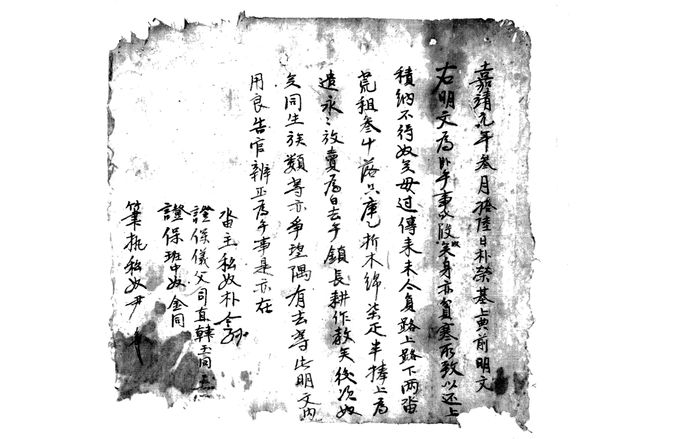(Translation) 1522年 朴榮基 土地賣買明文
| Primary Source | ||
|---|---|---|
 |
Title | |
| English | A Document of a Slave Selling land to his master | |
| Chinese | 1522年 朴榮基 土地賣買明文 | |
| Korean(RR) | 1522년 박영기(朴榮基) 토지매매명문(土地賣買明文) | |
| Text Details | ||
| Genre | Social Life and Economic Strategies | |
| Type | Record | |
| Author(s) | 私奴 朴今 | |
| Year | 1522 | |
| Source | ||
| Key Concepts | Trading | |
| Translation Info | ||
| Translator(s) | Participants of 2017 Summer Hanmun Workshop (Advanced Translation Group) | |
| Editor(s) | ||
| Year | 2017 | |
목차
- 1 Introduction
- 2 Original Script
- 3 Translation
- 3.1 Student 1 : (Irina)
- 3.2 Student 2 : (Kim Young)
- 3.3 Student 3 : (Masha)
- 3.4 Student 4 : (Jong Woo Park)
- 3.5 Student 5 : (Kanghun Ahn)
- 3.6 Student 6 : (Write your name)
- 3.7 Student 7 : (Write your name)
- 3.8 Student 8 : (Write your name)
- 3.9 Student 9 : Martin
- 3.10 Student 10 : (Write your name)
- 3.11 Student 11 : (Jinsook)
- 3.12 Student 12 : (dohee joeng)
- 3.13 Student 13 : (Write your name)
- 3.14 Student 14 : (Write your name)
- 4 Further Readings
Introduction
Original Script
| Classical Chinese | English |
|---|---|
|
嘉靖元年參月拾陸日朴榮基上典前明文 右明文爲臥乎事叱段奴矣身亦貧寒所致以還上 積納不得奴矣母邊傳來未今員路上路下兩畓 荒租參斗落只庫乙折木綿柒疋半捧上爲 遣永永放賣爲白去乎鎭長耕作敎矣後次奴 矣同生族類等亦爭望隅有去等此明文內 用良告官辨正爲乎事是亦在 畓主私奴朴今孫 證保依父司直韓玉同 證保班中奴金同 筆執私奴尹 |
(translation) |
Translation
Student 1 : (Irina)
In Korean texts Chinese characters are used for units of measurement, but often Korean units are different from Chinese. Is there a reliable source for checking Korean units of quantity, length, and so on?
- Discussion Questions:
Student 2 : (Kim Young)
- Discussion Questions:
1. This document proves that a slave could own and sell his own property. It seems contradictory at a glance that a slave was a property of the master but at the same time he could own his private property. Does this mean that the master had limited legal rights over his slaves? What does this document tell us about the rights of slaves as economic agents?
2. When they took this contract to the local office for notarization, did the office make a copy of it? Also, did each party make and get a copy of the same contract?
Student 3 : (Masha)
- Discussion Questions:
- What could be the potential benefits for a private slave to sell land aside from the one he mentioned in the document? What could be his other motivations? What were the benefits to keep the land? Could private slaves purchase land?
- Is it possible that, because of his status, a private slave had no choice but to sell the land to the one of a higher status upon the latter's request?
Student 4 : (Jong Woo Park)
- Discussion Questions:
Pak Kŭmson had to sell out his land because he could not pay back the grain loan (hwan'gok). Would it be common at that time that commoners or slaves were forced to sell out their means of production to repay their debt while rich yangban families accumulated wealth by taking advantage of this situation? Or would there be any cases that poor yangban had to sell out their properties to repay their debt to rich commoners or slaves?
Student 5 : (Kanghun Ahn)
1) In the second line, Doctor Jung read the term 환상 as 환자. How did it come about? And how can I figure out such "variants" of pronunciation in the Idu system?
2) The person who wrote down this contract was another private slave. And two witnesses of this deal are also slaves. Then, how can we re-appraise the social status of slaves in Choson Korea?
3)In this passage, a private slave is selling his land to his master. Was it a common case in early Choson? Then, were slaves allowed to keep their private property? If so, to what extent?
Student 6 : (Write your name)
- Discussion Questions:
In my impression, the "slaves" should be in a low status both socially and economically. But how Park Geumson, a private "slave", could own a land? How was the economical statue of the Joseon "slaves"? Were the public "slaves" also allowed to own their land?
Student 7 : (Write your name)
- Discussion Questions:
- As far as I know, the land belong to the master while the private slave acted as a tenant of the land. This transaction suggests that 1) the land was actually owned by the slave or 2) the slave sold the right to farm in the land to a third party. Which was the case?
- If it is the former then slave had the economic power to purchase and own land. Was there any law to regulate land-ownership of slave or land-ownership in general?
Student 8 : (Write your name)
- Discussion Questions:
Student 9 : Martin
- Discussion Questions:
1. There at least two slaves involved in the draft of the document. Are there hints concerning the relation between the selling slave and the buying yangban? (master and slave, distant family members, cases of tax fraud?)
Student 10 : (Write your name)
- Discussion Questions:
Student 11 : (Jinsook)
- Discussion Questions:
Assuming English-speaking readership, can we reorganize and translate this document in a typical English sale contract format that comprises of title, nonoperative part, operative part, and signature, etc.
Student 12 : (dohee joeng)
- Discussion Questions:
how did slaves learn Chinese character
Student 13 : (Write your name)
- Discussion Questions:
Student 14 : (Write your name)
- Discussion Questions: